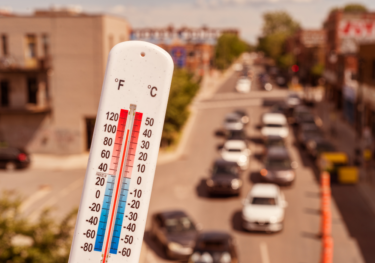Blog | 09 Aug 2024
Don’t just pack your swimsuit—summer travel plans now mean preparing for heatwaves

Shilpita Mathews
Senior Economist, Economics & Sustainability

Monday, 22 July 2024, was the hottest day ever recorded globally, according to the European Union’s Copernicus Climate Change Service, which has tracked temperatures since the 1940s. This record is unlikely to last very long. As forest fires grip Greece and Croatia and millions in Asia grappled with heatwaves earlier this year, extreme heat is becoming the new normal.
Heatwaves have numerous impacts on society such as heat-related illnesses, infrastructure disruptions, water scarcity and ecosystem changes. There have been various economic analyses looking at the costs of extreme heat, from the impact on employment, such as lost labour productivity, to increases in household food insecurity and additional burdens on the healthcare system. For example, a study by the Atlantic Council shows that extreme heat could cost the American economy up to US$ 100 billion annually through labour productivity losses alone. Beyond these quantifiable impacts, extreme heat is already resulting in lifestyle changes, such as shifting working hours and school closures.
School’s out for summer
One sector where the impact of extreme heat is most pronounced is travel and tourism. In fact, many countries where this sector makes up a high percentage of GDP are also exposed to high climate-related risk. An analysis of 185 countries shows that of all the countries where travel and tourism accounts for more than 10% of national GDP, more than half (53%) have above average climate risk globally based on the ND-GAIN Index. This index ranks countries on their vulnerability as well as preparedness to address climate-related risks such as extreme heat.
This is true even for Northern European countries like the UK and Switzerland, which typically fare well on climate-related preparedness. Researchers from the University of Oxford suggest that these countries are underprepared for a rise of 30% in days when cooling is needed if the global 1.5ºC target by 2050 is exceeded.
Climate-related impacts on the tourism sector can often put adaptation financing on the policy agenda, especially in tourism-dependent economies. For example, a recent article in the New York Times discusses how crop failure in Sicily has prompted the government to invest in water projects in order to safeguard the tourism sector from the effects of drought.
Walking on sunshine
It is no wonder then that policymakers are investing in heat preparedness. In our recent Greenomics episode on adaptation solutions, Jane Gilbert, Chief Heat Officer for Miami-Dade County in the US—the world’s first Chief Heat Officer—shared some of the city’s concerns and solutions.
The City of Miami welcomes approximately 19.2 million overnight visitors annually, with the tourism economy reliant on various outdoor and waterfront activities. This year, Miami experienced its hottest May on record, and the tourism sector is preparing for the summer and hurricane season ahead. Hotels, restaurants, and other tourism-related services face an increase in cooling costs coinciding with a surge in demand during peak season. This is only expected to increase as the number of extremely hot days in Miami is projected to increase fivefold by 2050.
As extreme heat becomes an increasingly frequent phenomena, it is important that governments and businesses invest in longer-term climate resilience. For example, the travel and tourism sector employs 260 million people globally, 38% of whom work in sectors like hospitality, which often involve outdoor activities exposed to heat-related risks. Climate adaptation is an inevitable response and early investors and innovators can benefit from business opportunities. According to the World Economic Forum, the climate adaptation market could be worth $2 trillion per year by 2026.
Emilie Mazzacurati, the Managing Partner of Tailwind, and also a guest on our Greenomics episode on adaptation solutions, explained that adaptation and resilience solutions include products and services that predict, prevent, mitigate and enable recovery from climate impacts like floods, heat waves, storms and wildfires. Although the market itself is in its early stages, many solutions exist, from climate intelligence services (e.g. early warning systems) to specific technologies (e.g. smart water meters) or uptake in activities (e.g. high precision agriculture).
Subscribe on: Apple Spotify | Soundcloud | By Email
Interestingly, the travel and tourism sector may stand to benefit most from such solutions as many travel destinations have substantial climate-related impacts, such as greenhouse gas emissions, as well as risks, like water scarcity. As we continue to face the realities a warming planet, it’s crucial to adapt and prepare for the challenges ahead. Whether you’re a traveller, a policymaker or a professional, understanding the importance of climate resilience and investing in adaptive measures will be key to navigating the future. The heat is on, but there are numerous opportunities to enhance resilience, helping find novel ways so that you can continue enjoying your vacations.
This blog is produced by our Economics & Sustainability team. To unlock the power of climate change and sustainability insights for your business, contact us.
Author

Shilpita Mathews
Senior Economist, Economics & Sustainability
07443323669

Shilpita Mathews
Senior Economist, Economics & Sustainability
London, United Kingdom
Shilpita joined Oxford Economics’ Economics & Sustainability team, bringing valuable experience from roles at Deloitte, Vivid Economics and McKinsey & Company, with a focus on sustainable finance and climate and nature risk assessment. Her work has spanned public and private sector clients, with a focus on financial institutions.
Shilpita holds a First-Class BA (Hons) in Land Economy from the University of Cambridge and a MSc in Environmental Economics & Climate Change (Hons) from the London School of Economics and Political Science.
Tags:
You may be interested in

Post
Greenomics – Ep. 12 | Beyond climate: Exploring nature-related risks for businesses
Climate change is a threat multiplier – disrupting ways of life, threatening food sources, and fundamentally changing the environment in which we live. In this episode we explore the potential impacts of climate change on vulnerable communities, from increased migratory and conflict pressures to the unique relationship between Indigenous populations and nature. Sarah Nelson is joined by three of the team from Oxford Economics who have been working to understand the profound social implications of these factors, Shilpita Mathews, Beatrice Tanjanco, and Ilana Gottlieb.
Find Out More
Post
The 10 cities with world-leading environments in 2024
At the top of the Quality of Life category are cities with lower inequality and residents that live long lives. Most of these cities also provide residents with access to a wide range of recreation and cultural amenities. They tend to be smaller than the leading cities in the Economics or Human Capital categories, and every city in the top 10 is located in Western Europe, bar one in Australia.
Find Out More
Post
Greenomics – Ep. 11 | Social disruption: The impact of climate change on vulnerable communities
Climate change is a threat multiplier – disrupting ways of life, threatening food sources, and fundamentally changing the environment in which we live. In this episode we explore the potential impacts of climate change on vulnerable communities, from increased migratory and conflict pressures to the unique relationship between Indigenous populations and nature. Sarah Nelson is joined by three of the team from Oxford Economics who have been working to understand the profound social implications of these factors, Shilpita Mathews, Beatrice Tanjanco, and Ilana Gottlieb.
Find Out More